Maguns Larsson talks about dunes architecture
Posted by Muse at Sunday, November 29, 2009Solar panel makers see business potential in UAE
Posted by Muse at Sunday, November 29, 2009
Solar panel manufacturers are hoping to pick up orders from alternative energy projects in the UAE and the Middle East.
A number of projects similar to Abu Dhabi's $22 billion (Dh80.8bn) Masdar zero-emissions city are being planned in Saudi Arabia, Qatar, Jordan and other countries, said an official from Sharp Solar.
They include Dubai's proposed eight million sq ft Enpark, the Qatar Energy Park, the Shams Maan project in Jordan and a zero-emissions city in Saudi.
"Masdar is the first major alternative energy project in the region but there are others in the pipeline in other emirates, Qatar and Jordan," Mohannad Al Shami, Solar Business Development Manager at Sharp Middle East, told Emirates Business at The Big 5 exhibition.
"Enpark, Dubai's first energy and environment free zone, is a long-term project to address power shortages in the city and the industrial areas of Sharjah, Ajman and Ras al Khaimah. It was announced earlier but has been delayed by the financial crisis.
"Such projects will require not only solar panels but also other power infrastructure. There is great potential for tapping solar energy in the emirates. There are 310 sunny days in the region and solar power can be integrated into the grid to provide power to factories during daytime."
Many industrial units in the free zones and other industrial areas in the Northern Emirates face acute power shortages and there are serious plans to develop alternative energy, especially solar power. "A number of factories in the Sharjah industrial zones and many new buildings in Ajman and other Northern Emirates depend on diesel generators," said Al Shami. "Some factories in industrial areas get only five or six hours of electricity each day."
Sharp, which is showcasing its solar products at The Big 5, has expanded its production in six factories to meet the expected demand.
Annual electricity demand in the UAE is growing at between seven and 10 per cent – double the global rate. Despite the slowdown, there will be a need for power and the proposed nuclear project will take many years to complete. – Emirates Business 24|7
Kseniya Simonova's Amazing Sand Drawing
Posted by Muse at Saturday, October 17, 2009![[Kseniya+Simonova+Sand+Drawing.jpg]](https://blogger.googleusercontent.com/img/b/R29vZ2xl/AVvXsEirqmXVH3Zpbjn-5ysIKOMvYxPbGvu8wq_CZssCKHKF3MrVV3Js6xCf8mqDefzU2RMKFD3rCuTxAgpl0nanaIE0dTxBb5ZwGsnZ27ZscVjhKMi0UwGuV54UH4vB5OjgAymOxrpfQT5aarM/s1600/Kseniya+Simonova+Sand+Drawing.jpg)

Building of the Year: RIBA Stirling Prize
Posted by Muse at Saturday, October 17, 2009
The building was opened to the public by Nigella Lawson and Maggie's Patron, Sarah Brown, on 29 April 2008.
The small, orange building with a roof that seems to float above it has enlivened a challenging corner of Fulham Palace Road, with a tranquil garden leading up to the entrance. Stone sculptures and wooden benches provide welcome and pleasant places to sit along the winding path to the front door.
Designed on a domestic scale, the centre's heart is the double-height kitchen, from which the three sitting rooms, library, courtyard gardens and a number of other spaces for more private or personal conversations, open. Light fills the interior, coming through the glazed walls at first floor level and through openings in the roof.
Despite being on a busy main road, the centre is surprisingly quiet inside, thanks to the protection of the wall and birch trees which wrap around it. The birch-faced ply and fair-face concrete finishes and furnishings - that include rugs by Paolo Lenti and furniture by Alvar Aalto - add to the relaxed, homely atmosphere.
Since opening its doors, the team at Maggie's have welcomed a constant stream of visitors with cups of tea, knowledge and support, as well as a wide range of events and activities, from lunch clubs to yoga. Maggie's Centre, London is already receiving in the region of 50 visitors per day.
Building also won the Civic Trust award see link
RMJM: win islamic architecture award for zliten campus, libya
Posted by Muse at Saturday, October 10, 2009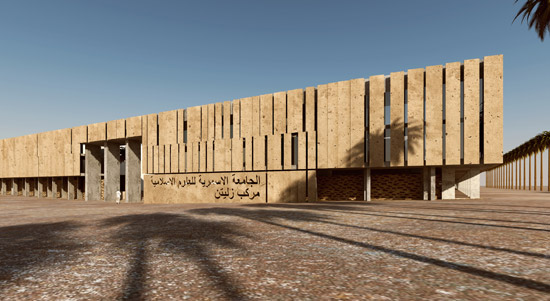
zliten campus at asmariya university for islamic sciences by RMJM architects
image courtesy RMJM architects
RMJM architects have received the islamic architecture award for their work on
the zliten campus at asmariya university for islamic sciences in libya at the cityscape
awards in dubai, 2009.
the zliten campus is a new branch of al asmariya university, located 75 miles southeast
of tripoli. RMJM’s architects designed a campus master plan for the development of
the 202-acre site. core academic functions are organized in four quadrants within
a perimeter habitable wall that houses faculty offices and academic support functions.
with a total build-out of more than 1 million square feet, the new campus provides
academic and support buildings, a conference and student center as well as
administration, library, recreation and residential spaces for a population of 4,600 students.
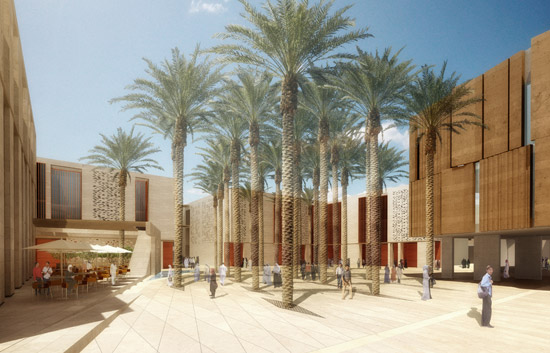
image courtesy RMJM architects

image courtesy RMJM architects
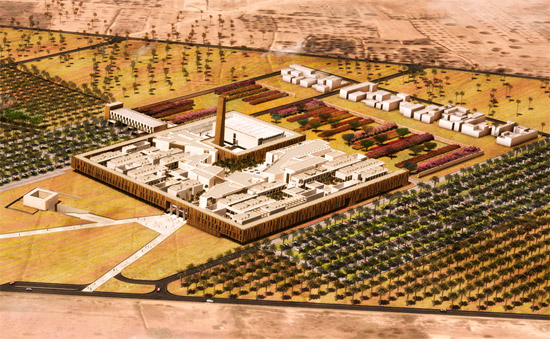
image courtesy RMJM architects
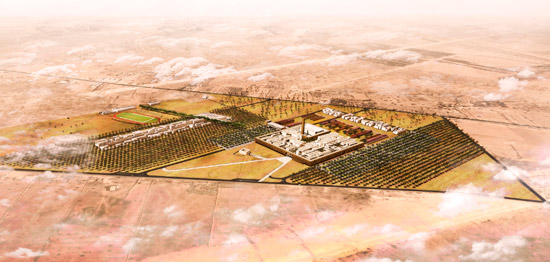
image courtesy RMJM architects
Revit and SketchUp Connection for 3ds Max Design 2010
Posted by Muse at Monday, October 05, 2009
The Connection Extension for Autodesk 3ds Max Design 2010 design visualization software offers a range of new and enhanced connectivity features exclusively to Autodesk Subscription program customers.
Enhanced Interoperability with CAD Packages
Bring solid models from many of your favorite CAD packages into 3ds Max Design 2010 for visual enhancement and export them back when you’re done. A new, high-fidelity SAT data translator makes it easier for designers to move solids-based design data between 3ds Max Design and Autodesk Revit Architecture software, Autodesk Inventor Professional software, or third-party CAD products such as Solidworks, Rhino, and FormZ. The SAT translator offers:
Import of geometric boundary representation data for trimmed surfaces, solids models, and assemblies as 3ds Max “bodies” (boundary representations based on NURBS).
The ability to retain imported data as the mathematical description of the surface. Users can determine and modify the conversion to polygons at any time.
Extensive Connectivity with Google SketchUp
Develop a concept in Google SketchUp software, and finesse it in 3ds Max Design. The Connection Extension for 3ds Max Design 2010 features a powerful new SKP file translator that enables you to bring SketchUp scenes into 3ds Max Design with a high degree of data preservation. And 3ds Max Design can now read thousands of free SketchUp models from the 3D Warehouse section of the Google website. The SKP translator includes:
Support for the double-faced materials workflow available in SketchUp, so arbitrary surface orientations don’t cause models to appear to be missing faces when displayed in 3ds Max Design.
Preservation of original pivot and scaling values of objects and instances, so designers don’t have to redo work.
Consolidation of material references. Multiple uses of the same SketchUp material are collected and referenced back to a single material, saving designers time if a change is required.
Streamlined Compositing with OpenEXR
Create professional-quality cinematic narratives. A rewritten OpenEXR translator makes it easier to work with compositing applications, enabling you to seamlessly blend CG animation with live action footage. The OpenEXR plug-in includes:
Advanced options for transferring extra elements, such as camera information and scripted data, reducing the number of iterations required to achieve a final result.
The ability to store render elements and G-buffer channels to EXR layers.
Intelligent Workflows
Save time and avoid costly geometry cleanup work with new, more effective workflows for dealing with complex scenes that enable you to:
Optimize display and rendering of imported solid and NURBS-based bodies.
Fix imported bodies with new repair tools.
Map the daylight system in SketchUp to the daylight system in 3ds Max Design, for a faster, more painless visualization workflow.
Select a layer from an OpenEXR file to use in a 3ds Max Design material. This functionality is similar to the way Adobe Photoshop software layers are used as textures in a material.
To download log on to your Autodesk subscription centre
Via Autodesk Press Release …
Architectural Design & Fabrication With Digital Technology
Posted by Muse at Sunday, August 16, 2009Urban Design for Sustainability
Posted by Muse at Thursday, August 13, 2009![[hammarby-sjöstad-007.jpg]](https://blogger.googleusercontent.com/img/b/R29vZ2xl/AVvXsEh3YyQs6nt0VNYO6Psm0330I6Nv_14EmOIPhyphenhyphen6iPE-E-xUCn3eJyjIwpnTHWASlNyLQmav8qad35-w2DtmmR63r3oEVNcKetqHiwRsUcPHpCuZHvf6sZo0sOdH2lPT9DEJgGIkbdjF4cRQ/s1600/hammarby-sj%C3%B6stad-007.jpg)

Perforated House Challenges and Reinvents Historic Architecture
Posted by Muse at Thursday, August 13, 2009
For architects working on projects in historic districts or in an area with a concentration of period buildings, solving problems can suffer reduced emphasis over adhering to the predetermined style. Kavellaris Urban Design(KUD) in Australia were challenged to design a house on a vacant lot in between a row of Victorian terrace houses and an Edwardian weatherboard house. The firm saw an opportunity to critique the surrounding historic buildings, many of which underwent predictable interior renovations to make them more ‘modern’. The architects concluded that the demand for the historic houses was based more on people’s romanticized nostalgia for the structures rather than their good design. To KUD, the ornamental facades dictated a ‘neighborhood character’ instead of responding to it.

KUD studied the terrace house, sampled the good parts and rewrote the rest. Top on their list was to address the lack of environmental sustainability in the old houses. One of the big areas for improvement over the old structures was to get more natural light into the building thus reducing energy consumption and allowing for natural ventilation. The north facing terrace redefines the “aussie” backyard reinforced by the childlike mural reminiscing on a past era and making commentary on the changing demography of the family unit and ultimately the inner city house typology. The perforated house incorporates north facing glass bi-folds doors and louvers for cross ventilation as the primary means of cooling.


In designing the exterior facade, KUD saw an opportunity to represent the past and also create something that was dynamic and engaged the community. The glass facade is opaque by day and has the traditional terrace detailing screened on to it. At night, interior light filters through the wall and transfoms the house into a glowing box. The entire front wall of the second floor can be opened up making the second floor a huge terrace.
Inside, traditional planing elements were borrowed but many of the walls can be moved and altered to make spaces either public or private. This flexibility allows the occupants to tune the interior experience and function to whatever the demands of their lifestyle require.
Want to see the house in 3d? KUD have uploaded a model to the Google Sketchup Warehouse. Preview it here.
source: Designtoinspire
The Highline – New York by JCFO & diller scofidio + renfro
Posted by Muse at Thursday, August 13, 2009Project: High Line Public Park project
The High Line design is led by James Corner Field Operations, with diller scofidio + renfro
Location: New York – USA
Photos by: Iwan Baan
————————————————————————————————–
Project Description:
“The high line, in collaboration with field operations, is a new 1.5-mile long public park built on an abandoned elevated railroad stretching from the meatpacking district to the hudson rail yards in manhattan.
Inspired by the melancholic, unruly beauty of this postindustrial ruin, where nature has reclaimed a once vital piece of urban infrastructure, the new park interprets its inheritance. It translates the biodiversity that took root after it fell into ruin in a string of site-specific urban microclimates along the stretch of railway that include sunny, shady, wet, dry, windy, and sheltered spaces.
Through a strategy of agri-tecture, part agriculture, part architecture- the high line surface is digitized into discrete units of paving and panting which are assembled along the 1.5 miles into a variety of gradients from 100% paving to 100% soft, richly vegetated biotopes. the paving system consists of individual pre-cast concrete planks with open joints to encourage emergent growth like wild grass through cracks in the sidewalk. the long paving units have tapered ends that comb into planting beds creating a textured, ‘pathless’ landscape where the public can meander in unscripted ways. the park accommodates the wild, the cultivated, the intimates, and the social. Access points are durational experiences designed to prolong the transition from the frenetic pace of city streets to the slow otherworldly landscape above. ”
Pavilion by Zaha Hadid
Posted by Muse at Thursday, August 13, 2009"Superimpositions of spatial structures with hidden traces of Burnham's organizational systems create unexpected results in the Burnham Pavilion. By using methods of overlaying, complexity is built up and inscribed in the structure."
-Zaha Hadid
Zaha Hadid's designs have the power to reinterpret and invigorate our understanding of what a building or a cityscape can be. Her fluid structures evolve from experimentation with cutting-edge technologies to reinterpret space itself.
Examining Burnham's drawings in the Plan of Chicago, Hadid was struck by how the city's diagonal streets open up the otherwise rigid street grid. Lengthening the drawn line of one of the diagonals, she marked where the street would fall if extended into Millennium Park. The design for the Burnham Pavilion incorporates that line, as the structural ribs and openings in the roof run parallel to an imaginary extension of Daniel Burnham's diagonal streets. The result is Hadid's sinuous pavilion that plays with shadow, light and space.
.jpg) More than 7,000 pieces of aluminum- no two alike- were individually bent and welded together, creating the pavilion's curvilinear form. Thousands of yards of fabric were custom tailored and tightly fit onto the interior and exterior aluminum-tube structure. The ridges of the aluminum are deliberately expressed through the external skin. The Marmon/Keystone Corporation donated much of the aluminum that provides the frame of curved ribs supporting the pavilion.
More than 7,000 pieces of aluminum- no two alike- were individually bent and welded together, creating the pavilion's curvilinear form. Thousands of yards of fabric were custom tailored and tightly fit onto the interior and exterior aluminum-tube structure. The ridges of the aluminum are deliberately expressed through the external skin. The Marmon/Keystone Corporation donated much of the aluminum that provides the frame of curved ribs supporting the pavilion.
.jpg) The interplay of light and shadow changes as the skylights cast shadows on the curving interior walls during the day. In the evening, a film installation by artist Thomas Gray will be projected onto the fluid fabric interior from different points inside the pavilion, creating a fully immersive effect. The film impressionistically reflects Chicago's transformation from 1909 to present, and includes the voices of people throughout the Chicago region sharing their visions of the future.
The interplay of light and shadow changes as the skylights cast shadows on the curving interior walls during the day. In the evening, a film installation by artist Thomas Gray will be projected onto the fluid fabric interior from different points inside the pavilion, creating a fully immersive effect. The film impressionistically reflects Chicago's transformation from 1909 to present, and includes the voices of people throughout the Chicago region sharing their visions of the future.
Accompanying the film is a creative multi-channel sound track by Lou Mallozzi of Experimental Sound Studio, Chicago. Both the interior and exterior surfaces of the pavilion are bathed in ever-changing lighting designed by Dear Productions.
The pavilion's materials are completely recyclable, and can be dismantled and reinstalled in its entirety elsewhere after the Centennial. (Construction Gallery coming soon.)
Photos by: Eric Y. Exit and Thomas Gray
Louis Vuitton: Art, Fashion and Architecture Book Video
Posted by Muse at Wednesday, August 12, 2009
Louis Vuitton: Art, Fashion and Architecture Book
Announced earlier this year, the Louis Vuitton: Art, Fashion and Architecture Book together with Camille Scherrer puts an animated spin on things to further highlight the book. For any Louis Vuitton fan and culture fan in general, this book should appeal to you as it uncovers Louis Vuitton’s involvement over the years in various facets of art, fashion and architecture as the book’s title would suggest.
Source: ILVOELV
Architecture firms focus on sustainable projects
Posted by Muse at Sunday, August 09, 2009The most recent forecast predicted a 16 percent decline in 2009, and an additional drop of almost 12 percent in 2010. In Atlanta, commercial architecture firms are seeing a similar downturn and are refocusing their firms’ business models to adapt.
“We are certainly seeing a decline in a lot of sectors we work in,” said Fred Perpall, managing principal of Beck’s Atlanta office. “Retail, corporate commercial and also spec office are probably going to be down for the next few years because we’ve got some big overbuilding.”
Perpall predicted commercial financing will come back before demand for commercial work ramps up again.
by Michael Hunter Via
Roof Tiles that Power Your Home
Posted by Muse at Sunday, August 09, 2009
Thanks to the work of SRS Energy, a Philadephia-based company that develops and manufactures premium solar roofing tiles designed to seamlessly integrate with traditional roofing products. (See image above where blue solar tiles have been added to a traditional mission-style tiled roof). Marketed as the Solé Power Tile™, these SRS Energy roofing tiles are designed to capture and convert sunlight into cost-saving electricity without compromising aesthetics. The tiles are offered as an integrated upgrade to a traditional roofing purchase. Added to the protection and curb appeal expected from a premium roofing system, homeowners are able to capitalize on solar electricity as sustainable value
Serpentine Gallery Pavilion by SANAA, London
Posted by Muse at Friday, August 07, 2009Home Remodeling using FAUX PANELS
Posted by Muse at Thursday, July 30, 2009

Today’s new faux panels are not only a reasonably priced answer to remodeling during a bad economy, but they are also very durable. The latest advances in technology have been perfected and used to come up with a material known as high density polyurethane, which makes these panels virtually indestructible. These stone veneer panels are not affected by water either due to the closed cell structure of the polyurethane, which makes it great for outdoor use or even indoor rooms that may get wet, such as the bathroom or the kitchen. For consumers looking for value for their money in this tight economy, the idea of durability makes these panels even more attractive when dollars are tight.
The realistic look that they provide is due to the fact that the panels are actually molded from actual brick, stone, and rock. Consumers can install these panels and it is difficult to tell they are not real stone. The panels are designed to interlock with each other as well, which means the design will look seamless when it is completed.
Whether consumers today want to add a stone, brick, or rock look to their home exteriors, interior rooms, patios, to office buildings, or other structures, with faux panels they can do so at a reasonable price. With many different styles and options available, FauxPanels.com offers not only affordable pricing, but excellent choices to consumers looking to improve their home at a low cost.
To find out more about faux panels and how you can use them to remodel during a recession, visithttp://www.fauxpanels.com for more information.
Holy Rosary Church Complex / Trahan Architects
Posted by Muse at Monday, July 27, 2009Architects: Trahan Architects, APAC
Location: Lousiana, USA
Project Architect: Victor F. “Trey” Trahan III, FAIA
Design team: Brad David, Kirk Edwards
Structural Engineer: Schrenk & Peterson Consulting Engineers
Mechanical, Electrical, Plumbing Engineer: Apex Engineering Corporation
BUILDER: Quality Design and Construction, Inc.
Project Area: 1,586 sqm
Project year: 2004
Photographer: Tim Hursley / The Arkansas Office
The design of the Holy Rosary Complex-comprised of an oratory, administrative building, and religious education building-for a rural Catholic Parish in South Louisiana, is an honest exploration of form, function, light and materials that results in an engaging and profound study in sacred space. Neither opulent nor austere, Holy Rosary Chapel presents a thoughtful meditation on sacred spaces and the spatial embodiment of spiritual experience.
The masterplan for the rural campus creates a strong sense of place and draws a distinction between the program’s sacred and secular components. Secular components of the campus take form as linear or “edge” buildings-an administrative block, two linear classroom bars, a religious education building-which form the courtyard in which the oratory is located. The oratory, or chapel, is the focus of the otherwise orthogonal composition, but is itself skewed to further underscore its importance and to create a sense of expectation.
Working with a limited palette of poured-in-place concrete, plate glass and cast glass, the architects created a meditative environment that places a high importance on spatial characteristics and the play of light on these humble materials.
Design of the oratory stems from the concept of the womb-a universal, pure and sacred space. All six sides of the oratory cube sides are equal in size, color and texture. The result is an interior space that feels encompassing, protective and mysterious.
Light enters through a variety of openings carved from the wall thickness without revealing context or light source beyond. In addition to giving occupants a sense of orientation, the obscured presence of light is symbolic of the paschal mystery of Christ.





















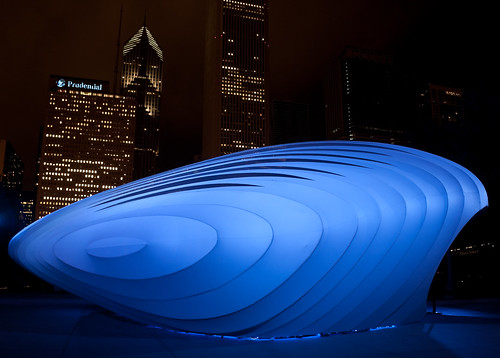



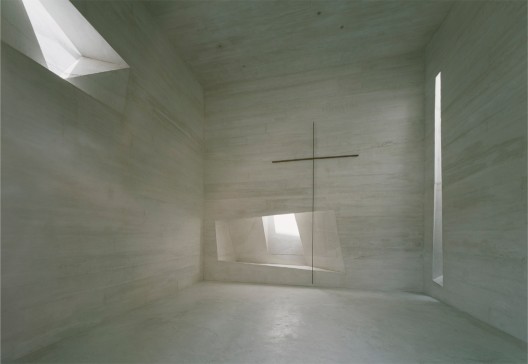
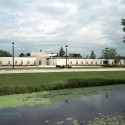
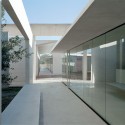
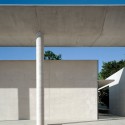
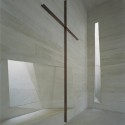
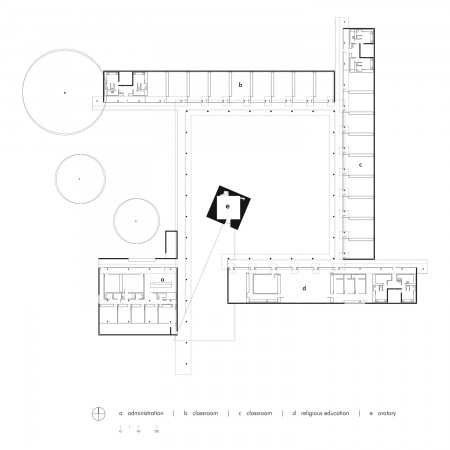
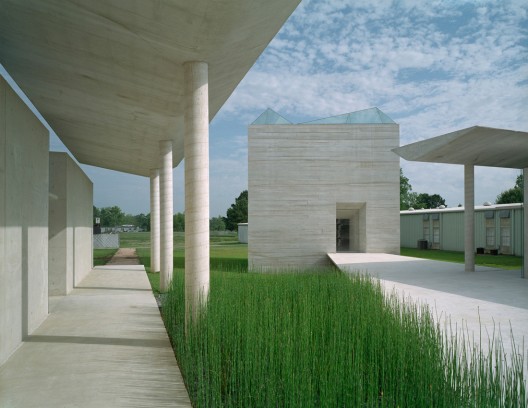
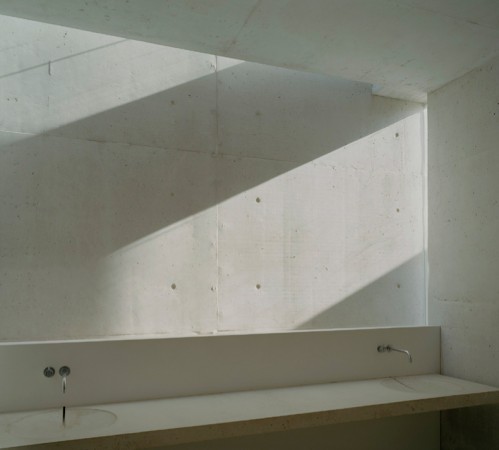
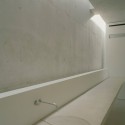
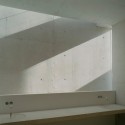
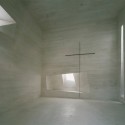
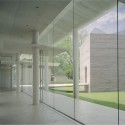
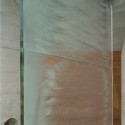
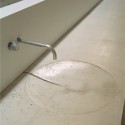
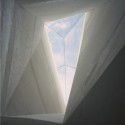
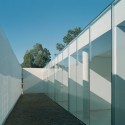
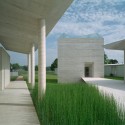
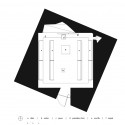
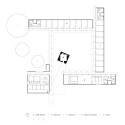
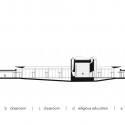


















3 comments: